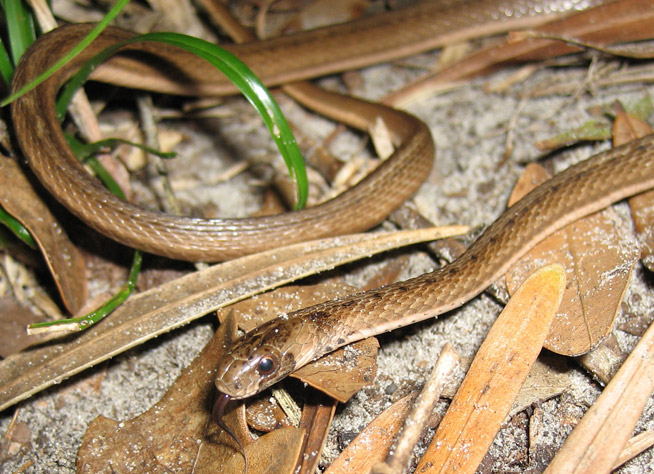
Biology:
The Eastern Ribbon snake is a variety of ribbon snake and is also called the Common Ribbon snake. It is found in the northeastern parts of the United States and is scientifically known as the Thamnophis sauritus sauritus.
It has a very thin body and that is why the name Ribbon snake is so appropriate. The length of a mature Eastern Ribbon Snake varies from 16 inches to 35 inches. It is black in color and has three bright yellow lines running parallel to the length of the body. One of these is at the center of the back while other two are on either side. The belly is greenish white in color and there are no blotches. There are black spots running over two rows between the side stripes and the back. They have keeled scales and there is single anal plate. The tail is long and covers about 30 percent of the body length. The labial scales as present around the mouth are either white or bright yellow in color and are unmarked. The front portion of the eyes also has yellow or white markings. Females grow slightly longer in size than the males. The eyes are large and the size of head is bigger and wider than the neck. The young ones at the time of birth vary from six to 10 inches in length.
Habitat:
The Eastern Ribbon Snakes are common in the entire northeastern region of the United States except the Appalachian Mountains and the southeastern parts of Canada. The chances of their presence increase as we move from the mountains to the coastal regions.
Eastern Ribbon Snakes are semi-aquatic in nature and can be easily found in the wetlands and on the corners of bogs, streams, salt marshes and lakes. They are equally comfortable in water and on land. With the arrival of winters, they move into the dens and goe into the state of hibernation.
Behavior:
Eastern Ribbon Snakes remain active throughout the year. However, in regions where there is too much cold, they are forced to go in the state of hibernation. They are not known to bite humans or anyone else if provoked. In case of a danger approaches, they either hide in the bushes or take to the water. Also, unlike water snakes, they do not dive into the water but glide over its surface. They also have the ability of secreting a foul smell from their anal glands to drive away the predator.
Because of their thin and small size, they move very fast. They prefer roaming, hunting and living alone but might share the hibernating site with other snakes.
Their vision is good and they can see the predator coming from a distance. They use the sense of touch and smell for communication. The forked tongues are capable of collecting the chemicals from the air and surrounding areas. These chemicals are fed by the tongue to a special organ located on the roof of the mouth. It interprets the chemicals for the brain to reach to a conclusion. They are also quite sensitive to vibrations.
Diet:
The Eastern Ribbon Snakes are known to feed on amphibians. Their diet includes small fishes, frogs, toads, tadpoles, salamanders and insects. The chances of you finding a female Eastern Ribbon Snake eating her own offspring are quite high. They hunt during the mornings and early evenings. They do not bite or tear the prey but swallow them whole.
Reproduction:
The mating usually occurs during the fall. However, females delay the fertilization and reproduction occurs during the spring season once they emerge from hibernation. Males insert a copulatory plug, which prevents the mating of other males with that female. Females give birth to offspring during late summer. The young ones are not dependent on the parents in any way and can start hunting soon after birth. They are nurtured inside the female’s body until the time of birth.
The gestation period is of three months and one female can give birth to four to up to 27 young ones at a time. They reach sexual maturity by the end of the second year.
Eastern Ribbon Snakes can survive up to 10 years in captivity but the lifespan in the wild is still a matter of debate.
Many people want to know how to kill a Eastern Ribbon Snake, but you don't need to. The
best way to get rid of Eastern Ribbon Snakes is to simply leave them alone. You can also
use a Eastern Ribbon Snake trap to catch them - that's one of the best ways for how to
remove Eastern Ribbon Snake. For more information, go to my
Snake Removal - How to Get Rid of Snakes home page.